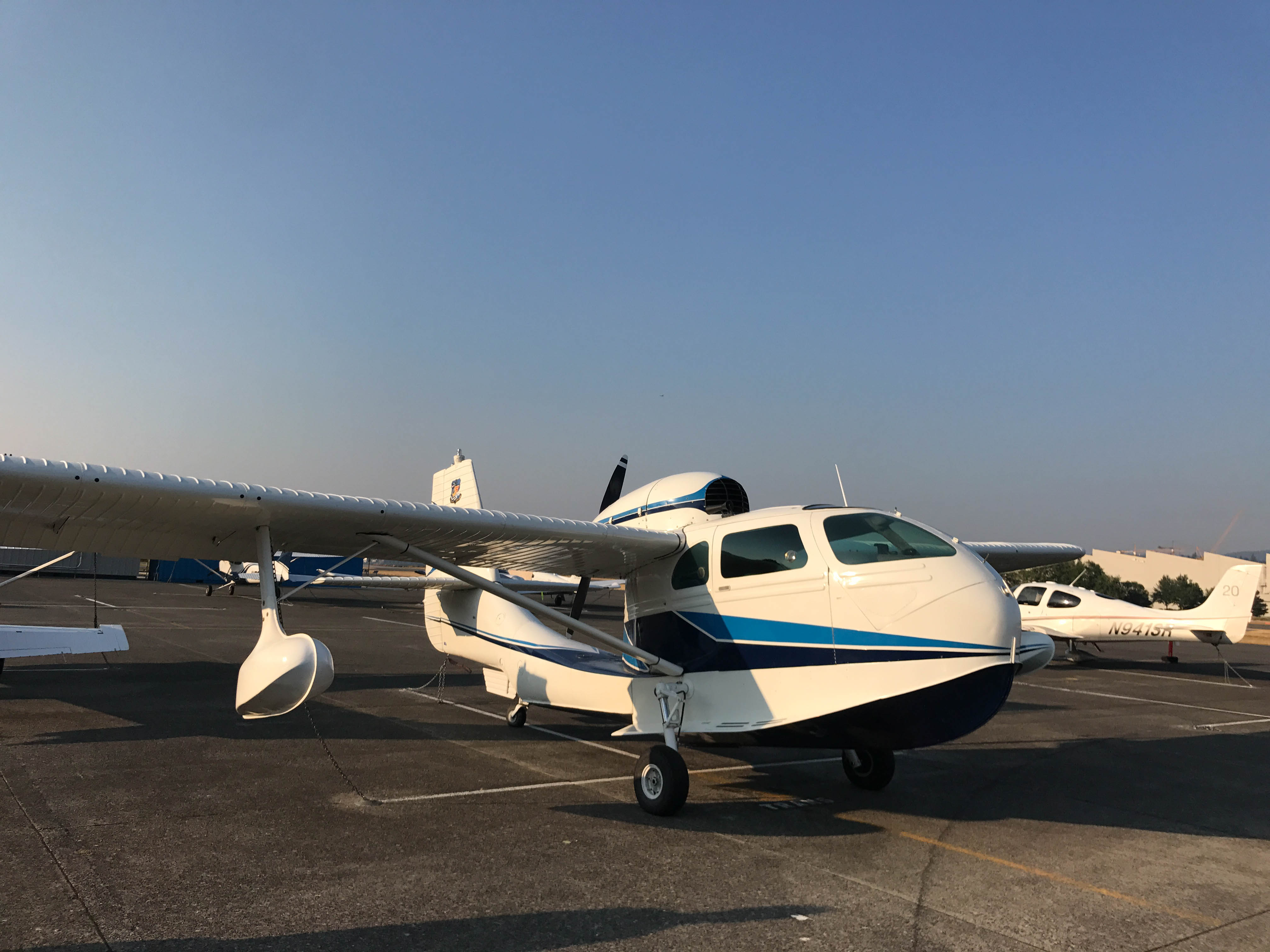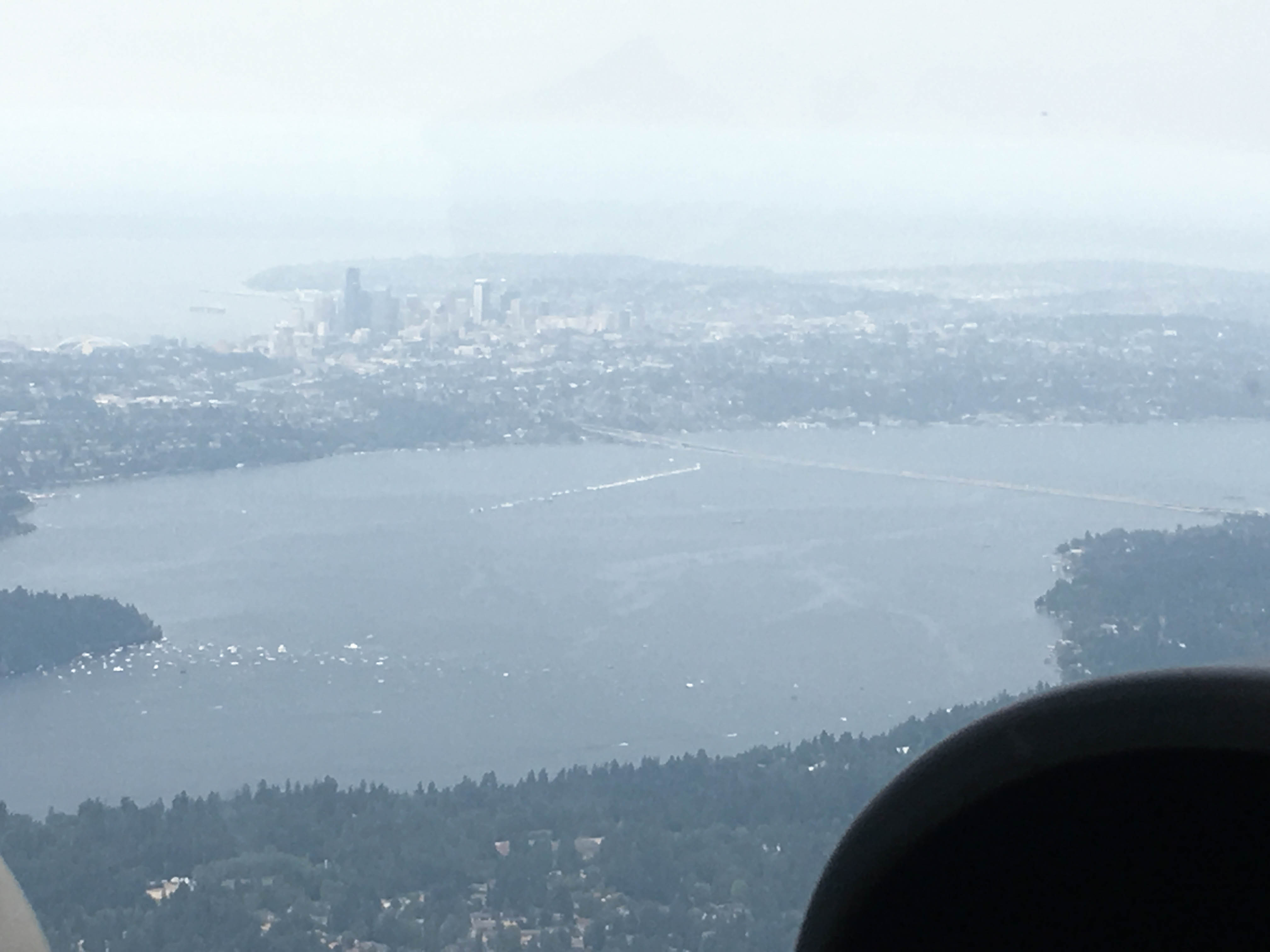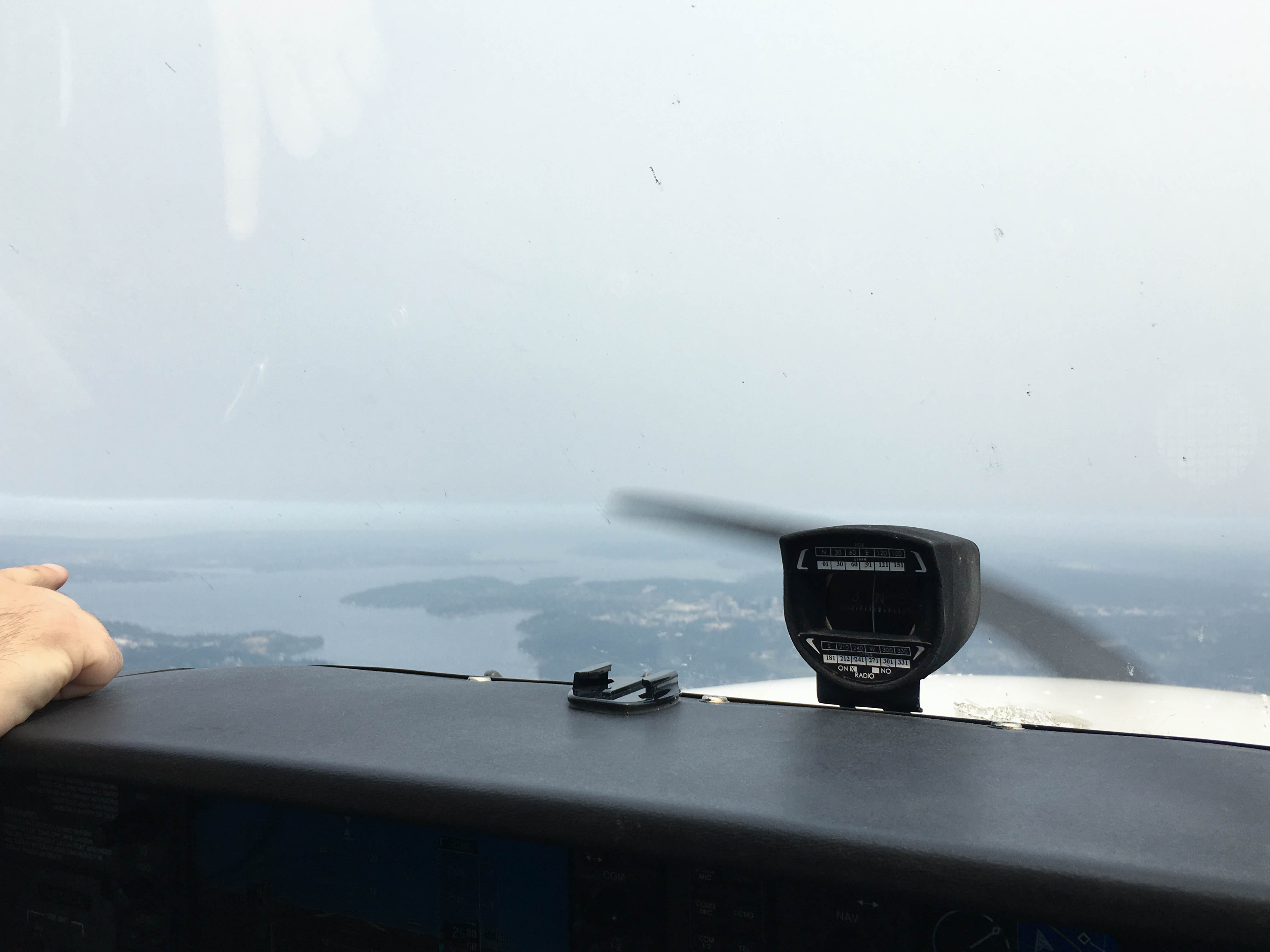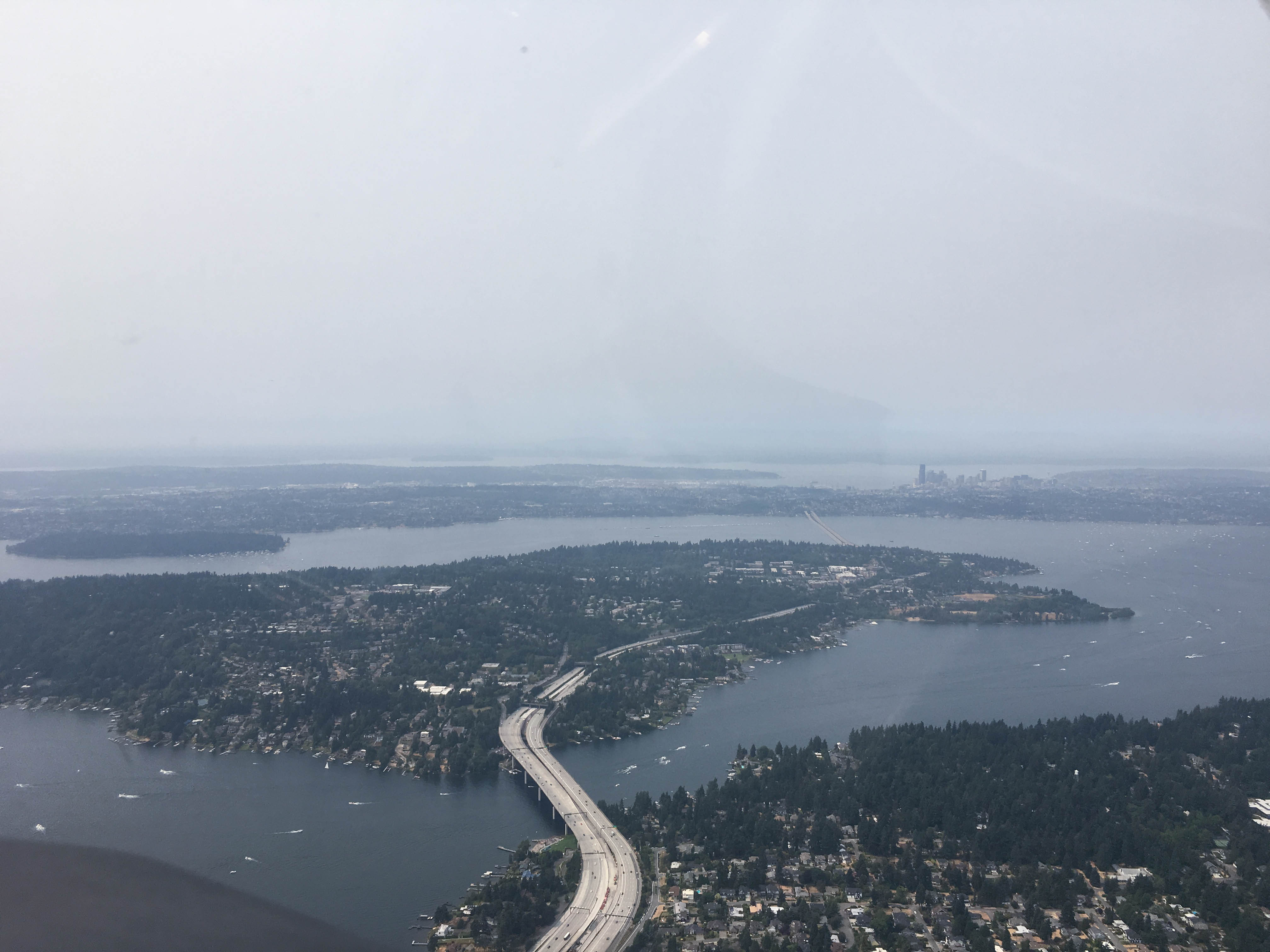Lessons 8 and 9: Landing is Hard
After a bit of yak shaving while I updated my blog, I’m now back to talking about flying. My typical flying schedule is Tuesday, Saturday, and Sunday. Lesson 8 was Tuesday, August first.
The Pacific Northwest over the last 10 days or so has suffered from a massive amount of smoke and haze, or in METAR terms, FU HZ. HZ stands for “haze”, FU is “fume”, from the French for smoke. There are a significant number of forest fires in British Columbia, and the winds (or lack therof) have caused the smoke from these fires to settle over the central Puget Sound area. This affected our flying.
On this Tuesday, though, the smoke wasn’t quite so bad. We had 6 miles of visibility, so we were all set in VFR conditions. Grant’s lesson plan for this day was some more simulated instrument training, ground reference maneuvers, and finally some pattern work. We wound up spending a bunch of time under the hood. I probably have mentioned this before, but the most common cause of pilot death is flight from “VMC to IMC”, or Visual Meteorological Conditions into Instrument MC, or more simply, flying from clear skies into a cloud. When this happens, you lose your reference to the horizon and the ground, so you don’t know visually if your wings are level. The instruments will tell you, but if you’re not trained for it, you’ll think you know better. Your inner ear will tell you (wrongly) that you’re cock-eyed, you’ll put in a correction, and before you know it, you’re in a dive and spin, you crash, and you die. This is how JFK Jr died. To really train for this, you get instrument-certified, and I’m planning on that after I get my private pilot. But, even as part of the private pilot training, the FAA wants you to at the very least know how to get out of the clouds if you inadvertantly fly in. The basic maneuver is a 180-degree turn. It goes something like this: “Oh crap, I flew into a cloud. I need to get outta here stat. What’s my current heading? Great. Start a standard rate turn until my heading is 180 from there. Watch the altimeter. Hold altitude”. So that’s what we practiced.

Grant then pulled the power, and said, “engine failure! What do you do?” I did much better this time, though I wasn’t perfect. I set airspeed and identified a field. I did half the checklist, then realized I wasn’t flying the airplane too well. I focused on that for a minute, and as I was about to do the second half of the checklist, Grant reminded me that I didn’t finish. I knew that, but his feedback was this: I have to be able to hit that checklist in seconds. Get it done and move on. That said, I was satisfied with my progress here.
We then went back to Renton and hit the pattern. We were on runway 34, which has a right-hand traffic pattern. I did much better than in lesson 7, where I couldn’t find my speed. We did 3 landings. I still have a tendency to dive bomb a little bit. My timing on the round-out and flare needs some more practice.
This past weekend was Sea Fair, which is a big event in Seattle. It includes a bunch of events on Lake Washington, and the Blue Angels come to town for an air show. The FAA set up a TFR, or Temporary Flight Restriction on Saturday and Sunday from 1:15-3PM. No air traffic could be up and running over the entirety of Lake Washington and the surrounding area during that time. Given that RNT’s pattern goes over Lake Washington, they decided to close the airport during this time. My Saturday lesson was 11-1, so we would just miss it.

We took off towards the Northeast. The smoke was still in town, and so visibility wasn’t more than 4 miles, just about VFR minimums. We left Renton’s airspace and entered the “Northeast Practice area”, an area that’s (you guessed it), northeast of Renton. I made my first radio call to the practice area (just letting other planes know where we were and what we were doing). I think it’s a good sign that Grant trusts me enough to make radio calls while flying the airplane. Progress! We started under the hood, and recovering from unusual attitudes. This time Grant had me look down at my knees and close my eyes. He took the controls and made a bunch of hard maneuvers. He’d say, “Open”, then I had to recover. I was still under the hood, so my recovery had to use only the instruments with no outside references. We did this 4 or 5 times. Grant would put the airplane into a turning climb or a turning descent, and I needed to recover to straight-and-level. You can’t trust your inner ear or the how it feels, you have to just use the instruments. I found this really fun, and had no real trouble recovering the airplane.
We then finished our ground reference maneuver training, with some more turns around a point and S-turns across a road. These maneuvers are about precision flying, and adjusting to wind. It wasn’t windy on this day so I didn’t really get to practice those adjustments, but I did work on precise turns and holding altitude. This went well.

It was about to get worse.
It was getting close to time, so we decided to head back to Renton, maybe fly the pattern a couple times. As we were just East of Bellevue, I made the radio call back to the tower to tell them we were inbound for touch-and-goes. I stomped on another person’s call (only one person can really be on the radios at a time), so I had to make the call a second time. She cleared us for a straight-in approach on 16. I was a little bit nervous. As I mentioned before, I know how to land from the pattern. You have the points where you slow down, where you descend, your points for extending the different flap settings. On a straight-in approach, you judge that all visually. Given that Grant was with me, he talked me through it. When we were still about 3 or 4 miles away, ATC told us to slow down. We were coming in over 100 knots, when we needed to be at 90 or less. This was me descending too fast. We corrected that. ATC cleared us for landing after the tow-plane (one of those planes that tows the big banners) that was on base in front of us. We then got the airplane more or less centered on the runway. We were a bit high, but we were still looking good for landing. I had full flaps in and we were slowing down. Then ATC says, “278CA, it’s not going to work, go around”. I was immediately frustrated, but of course followed instructions: put full power in, start climbing, then slowly retract the flaps.
Why did she wave us off? Was my landing clearly that far off that ATC thought we were being unsafe? I didn’t fully understand, but at that point I was both frustrated and embarassed.
We got back into the pattern to try again. We were out of time at this point, so Grant (who had assumed radio duties) called and told them we were doing a full-stop. ATC told us that things were super busy right now and please make a tidy base-final-landing. I over-shot the final turn a little bit, but was able to correct it. What happened next happened pretty fast, so I don’t really remember the exact chain of events. On a landing, you’re in a nose-down descent until you’re about 6 feet off the runway, then you “round out”, which basically means the airplane goes level, then right before you touch down, you “flare” - you pull the nose up. Knowing when to round out and flare take lots of reps, at least for me. I’m just not seeing it. Right as we needed to round out, I wasn’t rounding out. Grant put the back pressure in. Then as we were landing and I tried to flare, I’m pretty sure Grant did most of it. Already frustrated from the go-round, my frustration level peaked. It was directed mostly inwards (why the bleep am I not getting this?, but also towards Grant. I was hoping for some verbal cues, rather than just taking over the airplane.

We taxied off the runway, did our post-landing checklist, then headed back to the ramp. We got out of the airplane after shutting down, and pushed it back to its tie-down. I couldn’t talk as I worked to calm myself down. Grant and I headed to a room to debrief. We’ve been working together for about 2 months at this point, and I think we’ve been getting along pretty well, but I was pretty hot. He said, “You seem mad.” I told him I was, mostly at myself, but a little bit frustrated with him. We talked about it a bit, and I give him a lot of credit. He started by saying that my expectations were probably a little high, and that I’m right where I’m supposed to be in terms of progress. My landings aren’t supposed to be perfect yet. He said that on the landing, it happens fast, and his job is to ensure our safety, so he has to take the controls occasionally.
He then mentioned the go-round. I said, “Man, was our first approach that bad, that she had to wave us off?” “What?” he asked? “That straight-in, I knew we were high, but I thought we could recover.” Grant laughed. He said, “No! The tow plane in front of us hadn’t cleared the runway, and ATC was concerned we would come in while they were still there so she asked us to go around.” He then told me that the safety of our landing was exclusively in our hands, and that ATC can’t make that call. That made me feel much better, but also just a little concerned that I didn’t have the situational awareness to have understood that at the time.
As I write this a little over a week later, I’m much calmer. This is not an intuitive skill, at least for me. I really enjoy how much I’m learning, but I also recognize I’m going to have a bunch of ups and downs. My next two lessons wound up being ground training only, as the smoke and Sea Fair conspired to keep me out of the air. I’m on vacation this week, so I’ll have a 2 week break between flying sessions. I’ve been introduce to most of the core maneuvers now, so the next step in training is prepping for my first solo, and to do that, I’m going to have to practice landings incessantly. Hopefully, the next time I blog about landings, it’ll start with something like, “Finally, I got it!”